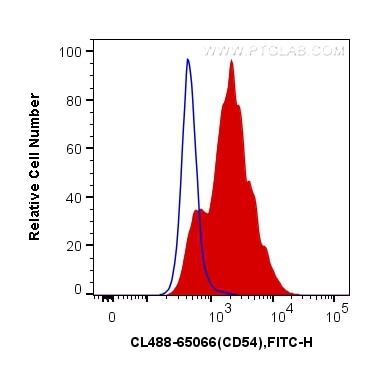CD54 Monoklonaler Antikörper
CD54 Monoklonal Antikörper für FC
Wirt / Isotyp
Ratte / IgG2b
Getestete Reaktivität
Maus
Anwendung
FC
Konjugation
CoraLite® Plus 488 Fluorescent Dye
CloneNo.
YN1/1.7.4
Kat-Nr. : CL488-65066
Synonyme
Galerie der Validierungsdaten
Geprüfte Anwendungen
| Erfolgreiche Detektion in FC | Maus-Splenozyten |
Empfohlene Verdünnung
| Anwendung | Verdünnung |
|---|---|
| This reagent has been pre-titrated and tested for flow cytometric analysis. The suggested use of this reagent is 5 µl per 10^6 cells in a 100 µl suspension or 5 µl per 100 µl of whole blood. | |
| Sample-dependent, check data in validation data gallery | |
Produktinformation
CL488-65066 bindet in FC CD54 und zeigt Reaktivität mit Maus
| Getestete Reaktivität | Maus |
| Wirt / Isotyp | Ratte / IgG2b |
| Klonalität | Monoklonal |
| Typ | Antikörper |
| Immunogen | Maus-NS-1-Zellen |
| Vollständiger Name | intercellular adhesion molecule 1 |
| GenBank-Zugangsnummer | BC008626 |
| Gene symbol | Icam1 |
| Gene ID (NCBI) | 15894 |
| Konjugation | CoraLite® Plus 488 Fluorescent Dye |
| Excitation/Emission maxima wavelengths | 493 nm / 522 nm |
| Form | Liquid |
| Reinigungsmethode | Affinitätsreinigung |
| Lagerungspuffer | PBS mit 0,1% Natriumazid und 0,5% BSA, pH 7,3. |
| Lagerungsbedingungen | Bei 2-8°C lagern. Vor Licht schützen. |
Hintergrundinformationen
ICAM-1 (CD54) is a 90-kDa transmembrane glycoprotein of the immunoglobulin superfamily and is critical for the firm attachment and transmigration of leukocytes out of blood vessels and into tissues (PMID: 19307690). ICAM-1 is expressed by several cell types, typically on endothelial cells and cells of the immune system, and its expression can be up-regulated by various stimuli, including TNF-α, INF-γ, IL-1 and thrombin (PMID: 3086451; 9694714; 15979056). It is a ligand for LFA-1 and Mac-1, serves as a receptor for rhinovirus, and is one of several receptors used by Plasmodium falciparum (PMID: 2566624; 2538244; 2475784).
Protokolle
| Produktspezifische Protokolle | |
|---|---|
| FC protocol for CL Plus 488 CD54 antibody CL488-65066 | Protokoll herunterladen |
| Standard-Protokolle | |
|---|---|
| Klicken Sie hier, um unsere Standardprotokolle anzuzeigen |


